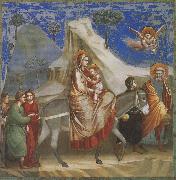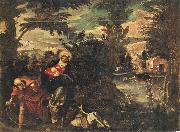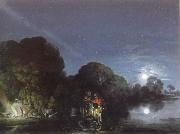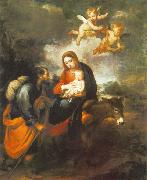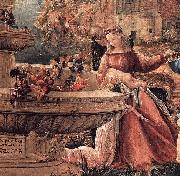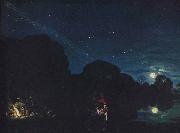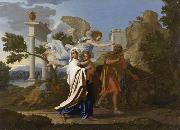Wholesale Oil Painting No Minimum |
|||||||||||
|
|
|||||||||||

|
|||||||||||
|
|
|
||||||||
|
|
||||||||
Flight into Egypt
Flight into Egypt Painting ID:: 1131 |
1609
Pinakothek, Munich 1609 Pinakothek, Munich |
|||||||
|
|
||||||||
James EnsorBelgian 1860-1949 Belgian painter, printmaker and draughtsman. No single label adequately describes the visionary work produced by Ensor between 1880 and 1900, his most productive period. His pictures from that time have both Symbolist and Realist aspects, and in spite of his dismissal of the Impressionists as superficial daubers he was profoundly concerned with the effects of light. His imagery and technical procedures anticipated the colouristic brilliance and violent impact of Fauvism and German Expressionism and the psychological fantasies of Surrealism. Ensor most memorable and influential work was almost exclusively produced before 1900, but he was largely unrecognized before the 1920s in his own country. His work was highly influential in Germany, however: Emil Nolde visited him in 1911, and was influenced by his use of masks; Paul Klee mentions him admiringly in his diaries; Erich Heckel came to see him in the middle of the war and painted his portrait (1930; Cologne, Wallraf-Richartz-Mus.); Alfred Kubin owned several of his prints, while Marc Chagall and George Grosz also adapted certain elements from Ensor. All the artists of the Cobra group saw him as a master. He influenced many Belgian artists including Leon Spilliaert, Rik Wouters, Constant Permeke, Frits van den Berghe, Paul Delvaux and Pierre Alechinsky. |
||||||||
|
|
||||||||
|
|
Flight into Egypt
Flight into Egypt Painting ID:: 37432 |
mk126
mk126 |
||||||
|
|
||||||||
GIOTTO di BondoneItalian Early Renaissance Painter, 1267-1337 Italian painter and designer. In his own time and place he had an unrivalled reputation as the best painter and as an innovator, superior to all his predecessors, and he became the first post-Classical artist whose fame extended beyond his lifetime and native city. This was partly the consequence of the rich literary culture of two of the cities where he worked, Padua and Florence. Writing on art in Florence was pioneered by gifted authors and, although not quite art criticism, it involved the comparison of local artists in terms of quality. The most famous single appreciation is found in Dante's verses (Purgatory x) of 1315 or earlier. Exemplifying the transience of fame, first with poets and manuscript illuminators, Dante then remarked that the fame of Cimabue, who had supposed himself to be the leader in painting, had now been displaced by Giotto. Ironically, this text was one factor that forestalled the similar eclipse of Giotto's fame, which was clearly implied by the poet. |
||||||||
|
|
||||||||
|
|
Flight into Egypt
Flight into Egypt Painting ID:: 40128 |
mk156
200x185cm
1303-05
mk156 200x185cm 1303-05 |
||||||
|
|
||||||||
Adam Elsheimer1578-1610 German Adam Elsheimer Locations German painter, printmaker and draughtsman, active in Italy. His small paintings on copper established him after his brief life as the most singular and influential German artist to follow Derer. Their grand conception in terms of monumental figures and poetic landscape and their meticulous, miniature-like execution were admired by Rubens and came to influence many 17th-century artists, including Rembrandt. Most were produced in Rome after 1600: the limits of this oeuvre and its chronology are extremely hard to establish. |
||||||||
|
|
||||||||
|
|
Flight into Egypt
Flight into Egypt Painting ID:: 40410 |
mk156
1609
Oil on copper
31x41cm
mk156 1609 Oil on copper 31x41cm |
||||||
|
|
||||||||
TINTORETTO, JacopoBirth Year:, 1518. Death Year:, 1594 |
||||||||
|
|
||||||||
|
|
Flight into Egypt
Flight into Egypt Painting ID:: 41145 |
mk157
1583-87
Oil on canvas
422x580cm
mk157 1583-87 Oil on canvas 422x580cm |
||||||
|
|
||||||||
Adam ElsheimerGerman Baroque Era Painter, 1578-1610 German painter, printmaker and draughtsman, active in Italy. His small paintings on copper established him after his brief life as the most singular and influential German artist to follow D?rer. Their grand conception in terms of monumental figures and poetic landscape and their meticulous, miniature-like execution were admired by Rubens and came to influence many 17th-century artists, including Rembrandt. |
||||||||
|
|
||||||||
|
|
flight into egypt
flight into egypt Painting ID:: 56046 |
mk247
1609,oil on copper,12.25x16.125 in,30.6x41.5 cm,alte pinakothek,munich,germany mk247 1609,oil on copper,12.25x16.125 in,30.6x41.5 cm,alte pinakothek,munich,germany |
||||||
|
|
||||||||
Bartolome Esteban MurilloSpanish 1618-1682 Bartolome Esteban Murillo Galleries Murillo began his art studies under Juan del Castillo in Seville. Murillo became familiar with Flemish painting; the great commercial importance of Seville at the time ensured that he was also subject to influences from other regions. His first works were influenced by Zurbaran, Jusepe de Ribera and Alonso Cano, and he shared their strongly realist approach. As his painting developed, his more important works evolved towards the polished style that suited the bourgeois and aristocratic tastes of the time, demonstrated especially in his Roman Catholic religious works. In 1642, at the age of 26 he moved to Madrid, where he most likely became familiar with the work of Velazquez, and would have seen the work of Venetian and Flemish masters in the royal collections; the rich colors and softly modeled forms of his subsequent work suggest these influences. He returned to Seville in 1645. In that year, he painted thirteen canvases for the monastery of St. Francisco el Grande in Seville which gave his reputation a well-deserved boost. Following the completion of a pair of pictures for the Seville Cathedral, he began to specialise in the themes that brought him his greatest successes, the Virgin and Child, and the Immaculate Conception. After another period in Madrid, from 1658 to 1660, he returned to Seville. Here he was one of the founders of the Academia de Bellas Artes (Academy of Art), sharing its direction, in 1660, with the architect, Francisco Herrera the Younger. This was his period of greatest activity, and he received numerous important commissions, among them the altarpieces for the Augustinian monastery, the paintings for Santa Mar??a la Blanca (completed in 1665), and others. |
||||||||
|
|
||||||||
|
|
Flight into Egypt
Flight into Egypt Painting ID:: 62326 |
155,5 x 125 cm Museum of Fine Arts, Budapest Murillo painted several variants of this popular subject, this is not the best among them. There is an autograph variant of this painting in the Pushkin Museum, Moscow 155,5 x 125 cm Museum of Fine Arts, Budapest Murillo painted several variants of this popular subject, this is not the best among them. There is an autograph variant of this painting in the Pushkin Museum, Moscow |
||||||
|
|
||||||||
GIOTTO di BondoneItalian Early Renaissance Painter, 1267-1337 Italian painter and designer. In his own time and place he had an unrivalled reputation as the best painter and as an innovator, superior to all his predecessors, and he became the first post-Classical artist whose fame extended beyond his lifetime and native city. This was partly the consequence of the rich literary culture of two of the cities where he worked, Padua and Florence. Writing on art in Florence was pioneered by gifted authors and, although not quite art criticism, it involved the comparison of local artists in terms of quality. The most famous single appreciation is found in Dante's verses (Purgatory x) of 1315 or earlier. Exemplifying the transience of fame, first with poets and manuscript illuminators, Dante then remarked that the fame of Cimabue, who had supposed himself to be the leader in painting, had now been displaced by Giotto. Ironically, this text was one factor that forestalled the similar eclipse of Giotto's fame, which was clearly implied by the poet. |
||||||||
|
|
||||||||
|
|
Flight into Egypt
Flight into Egypt Painting ID:: 62984 |
1304-06 Fresco, 200 x 185 cm Cappella Scrovegni (Arena Chapel), Padua On a narrow rocky path, the procession seems to move past the viewer. Equipped with everyday objects, everyone is in motion, looking at one another and talking to one another - only the Virgin Mary sits still and unmoving. The statuesque nature other upright position is further reinforced by the rock behind. Although the child is as natural as can be, the central figures in the picture thus stand out from their surroundings and have a sublime effect. Artist: GIOTTO di Bondone Painting Title: No. 20 Scenes from the Life of Christ: 4. Flight into Egypt , 1301-1350 Painting Style: Italian , , religious 1304-06 Fresco, 200 x 185 cm Cappella Scrovegni (Arena Chapel), Padua On a narrow rocky path, the procession seems to move past the viewer. Equipped with everyday objects, everyone is in motion, looking at one another and talking to one another - only the Virgin Mary sits still and unmoving. The statuesque nature other upright position is further reinforced by the rock behind. Although the child is as natural as can be, the central figures in the picture thus stand out from their surroundings and have a sublime effect. Artist: GIOTTO di Bondone Painting Title: No. 20 Scenes from the Life of Christ: 4. Flight into Egypt , 1301-1350 Painting Style: Italian , , religious |
||||||
|
|
||||||||
Albrecht AltdorferGerman 1480-1538 Albrecht Altdorfer Galleries He most often painted religious scenes, but is mainly famous as the first frequent painter of pure landscape, and also compositions dominated by their landscape. Taking and developing the landscape style of Lucas Cranach the Elder, he shows the hilly landscape of the Danube valley with thick forests of drooping and crumbling firs and larches hung with moss, and often dramatic colouring from a rising or setting sun. His Landscape with footbridge (National Gallery, London) of 1518-20 is claimed to be the first pure landscape in oil. He also made many fine finished drawings, mostly landscapes, in pen and watercolour. His best religious scenes are intense, sometimes verging on the expressionistic, and often depict moments of intimacy between Christ and his mother, or others. His most famous religious artwork is the The Legend of St. Sebastian and the Passion of Christ that decorated the altar in the St. Florian monastery in Linz, Austria. He often distorts perspective to subtle effect. His donor figures are often painted completely out of scale with the main scene, as in paintings of the previous centuries. He also painted some portraits; overall his painted oeuvre was not large. |
||||||||
|
|
||||||||
|
|
Flight into Egypt
Flight into Egypt Painting ID:: 83929 |
1510(1510)
Medium Oil on panel
cyf 1510(1510) Medium Oil on panel cyf |
||||||
|
|
||||||||
Adam ElsheimerGerman Baroque Era Painter, 1578-1610 German painter, printmaker and draughtsman, active in Italy. His small paintings on copper established him after his brief life as the most singular and influential German artist to follow D?rer. Their grand conception in terms of monumental figures and poetic landscape and their meticulous, miniature-like execution were admired by Rubens and came to influence many 17th-century artists, including Rembrandt. |
||||||||
|
|
||||||||
|
|
Flight into Egypt
Flight into Egypt Painting ID:: 94801 |
c. 1609
Type Oil on copper
Dimensions 31 cm x 41 cm (12 in x 16 in)
cyf c. 1609 Type Oil on copper Dimensions 31 cm x 41 cm (12 in x 16 in) cyf |
||||||
|
|
||||||||
Nicolas PoussinFrench 1594-1665 Nicolas Poussin Galleries The finest collection of Poussin's paintings, in addition to his drawings, is located in the Louvre in Paris. Besides the pictures in the National Gallery and at Dulwich, England possesses several of his most considerable works: The Triumph of Pan is at Basildon House, near to Pangbourne, (Berkshire), and his great allegorical painting of the Arts at Knowsley. The later version of Tancred and Erminia is at the Barber Institute in Birmingham. At Rome, in the Colonna and Valentini Palaces, are notable works by him, and one of the private apartments of Prince Doria is decorated by a great series of landscapes in distemper. Throughout his life he stood aloof from the popular movement of his native school. French art in his day was purely decorative, but in Poussin we find a survival of the impulses of the Renaissance coupled with conscious reference to classic work as the standard of excellence. In general we see his paintings at a great disadvantage: for the color, even of the best preserved, has changed in parts, so that the harmony is disturbed; and the noble construction of his designs can be better seen in engravings than in the original. Among the many who have reproduced his works, Audran, Claudine Stella, Picart and Pesne are the most successful. |
||||||||
|
|
||||||||
|
|
Flight into Egypt
Flight into Egypt Painting ID:: 94893 |
1657(1657)
Medium huile sur toile
Dimensions 97 x 133 cm
cyf 1657(1657) Medium huile sur toile Dimensions 97 x 133 cm cyf |
||||||
|
|
||||||||
|
Nicolas Poussin French 1594-1665 Nicolas Poussin Galleries The finest collection of Poussin's paintings, in addition to his drawings, is located in the Louvre in Paris. Besides the pictures in the National Gallery and at Dulwich, England possesses several of his most considerable works: The Triumph of Pan is at Basildon House, near to Pangbourne, (Berkshire), and his great allegorical painting of the Arts at Knowsley. The later version of Tancred and Erminia is at the Barber Institute in Birmingham. At Rome, in the Colonna and Valentini Palaces, are notable works by him, and one of the private apartments of Prince Doria is decorated by a great series of landscapes in distemper. Throughout his life he stood aloof from the popular movement of his native school. French art in his day was purely decorative, but in Poussin we find a survival of the impulses of the Renaissance coupled with conscious reference to classic work as the standard of excellence. In general we see his paintings at a great disadvantage: for the color, even of the best preserved, has changed in parts, so that the harmony is disturbed; and the noble construction of his designs can be better seen in engravings than in the original. Among the many who have reproduced his works, Audran, Claudine Stella, Picart and Pesne are the most successful. Flight into Egypt 1657(1657) Medium huile sur toile Dimensions 97 x 133 cm cyf |
||||||||
|
|
||||||||
|
Prev Next
|
||||||||
|
|
||||||||
|
Related Paintings to Nicolas Poussin :. |
||||||||
|
|
||||||||
|
CONTACT US |



